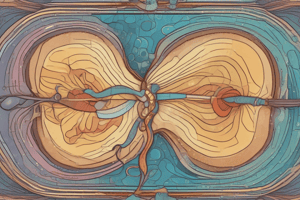Podcast
Questions and Answers
Explain the significance of dividing lower urinary tract symptoms (LUTSs) into irritative and obstructive categories.
Explain the significance of dividing lower urinary tract symptoms (LUTSs) into irritative and obstructive categories.
Dividing LUTSs into irritative and obstructive categories helps understand the underlying cause and stage of the disease, as irritative symptoms typically occur late in the disease course due to long-standing obstruction at the bladder neck.
Describe the potential causes of LUTSs other than benign prostatic hyperplasia (BPH).
Describe the potential causes of LUTSs other than benign prostatic hyperplasia (BPH).
Other potential causes of LUTSs include bladder cancer or stones, urinary tract infection (UTI), and urethral stricture.
Explain the relationship between obstructive symptoms and the term 'prostatism' or 'bladder outlet obstruction'.
Explain the relationship between obstructive symptoms and the term 'prostatism' or 'bladder outlet obstruction'.
Obstructive symptoms, such as poor urinary flow, hesitancy in initiation of micturition, post-micturition dribble, and sensation of incomplete emptying, are also referred to as 'prostatism' or 'bladder outlet obstruction'.
Describe the potential consequence of long-standing obstruction at the bladder neck and its associated symptom.
Describe the potential consequence of long-standing obstruction at the bladder neck and its associated symptom.
Explain the potential complication of acute retention of urine and its associated symptom.
Explain the potential complication of acute retention of urine and its associated symptom.
Discuss the impact of lower urinary tract symptoms (LUTSs) on the quality of life of men with benign prostatic hyperplasia (BPH).
Discuss the impact of lower urinary tract symptoms (LUTSs) on the quality of life of men with benign prostatic hyperplasia (BPH).
Men with BPH can develop bothersome lower urinary tract symptoms (LUTSs) that can impact negatively on their quality of _____.
Men with BPH can develop bothersome lower urinary tract symptoms (LUTSs) that can impact negatively on their quality of _____.
LUTSs can have different aetiologies including bladder cancer or stones, urinary tract infection (UTI) or urethral _____.
LUTSs can have different aetiologies including bladder cancer or stones, urinary tract infection (UTI) or urethral _____.
Irritative symptoms typically occur late in the disease course; and result from long-standing obstruction at the bladder _____.
Irritative symptoms typically occur late in the disease course; and result from long-standing obstruction at the bladder _____.
Frequency (urination eight or more times a day) Nocturia (the inability to delay urination) Urgency and urge incontinence are symptoms of failure of urine _____.
Frequency (urination eight or more times a day) Nocturia (the inability to delay urination) Urgency and urge incontinence are symptoms of failure of urine _____.
Obstructive symptoms include poor urinary flow (weak urine stream), hesitancy in initiation of micturition, and sensation of incomplete _____.
Obstructive symptoms include poor urinary flow (weak urine stream), hesitancy in initiation of micturition, and sensation of incomplete _____.
Suprapubic pain can result from bladder _____.
Suprapubic pain can result from bladder _____.
Flashcards are hidden until you start studying




